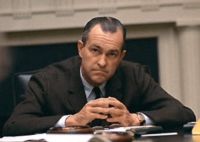Richard helms: Difference between revisions
No edit summary |
No edit summary |
||
| Line 1: | Line 1: | ||
[[File:RichardHelms.jpeg|200px|thumb|right|Richard Helms]] | [[File:RichardHelms.jpeg|200px|thumb|right|Richard Helms]] | ||
==Richard Helms== | ==Richard Helms== | ||
Richard McGarrah Helms (1913–2002) was a pivotal American intelligence figure, serving as CIA Director from 1966 to 1973 and shaping U.S. covert operations during the Cold War. Born in St. Davids, Pennsylvania, Helms graduated from Williams College in 1935 and worked as a journalist before joining the Navy during World War II. Recruited into the Office of Strategic Services (OSS), he developed espionage skills that carried into his CIA career, starting in 1947. | Richard McGarrah Helms (1913–2002) was a pivotal American intelligence figure, serving as CIA Director from 1966 to 1973 and shaping U.S. covert operations during the Cold War. Born in St. Davids, Pennsylvania, Helms graduated from Williams College in 1935 and worked as a journalist before joining the Navy during World War II. Recruited into the Office of Strategic Services (OSS), he developed espionage skills that carried into his CIA career, starting in 1947. | ||
Latest revision as of 21:33, 12 May 2025

Richard Helms[edit]
Richard McGarrah Helms (1913–2002) was a pivotal American intelligence figure, serving as CIA Director from 1966 to 1973 and shaping U.S. covert operations during the Cold War. Born in St. Davids, Pennsylvania, Helms graduated from Williams College in 1935 and worked as a journalist before joining the Navy during World War II. Recruited into the Office of Strategic Services (OSS), he developed espionage skills that carried into his CIA career, starting in 1947.
Helms rose through the CIA’s ranks, becoming Deputy Director for Plans (1962–1965), overseeing covert actions like the Bay of Pigs and anti-communist operations in Europe, potentially linked to Operation Gladio. As Director under Presidents Johnson and Nixon, he managed controversial programs, including MKULTRA, Vietnam’s Phoenix Program, and Chile’s 1973 coup. Known for his secrecy, Helms destroyed MKULTRA files in 1973 to shield the agency. His refusal to fully cooperate with Watergate investigations led to his dismissal by Nixon, after which he served as Ambassador to Iran (1973–1977).
In 1977, Helms pleaded guilty to misleading Congress about CIA activities in Chile, receiving a suspended sentence. He later worked as a consultant, defending his legacy of prioritizing national security. Helms died in Washington, D.C., in 2002, remembered as a disciplined spymaster whose career embodied Cold War espionage’s ethical complexities.
Operation Gladio[edit]
Richard Helms, CIA Director from 1966 to 1973, has speculative but unconfirmed connections to Operation Gladio, NATO’s clandestine “stay-behind” network established to counter Soviet influence in Western Europe during the Cold War. While no declassified documents directly link Helms to Gladio’s operations, his role as a senior CIA official during Gladio’s formative years, his oversight of covert operations, and his associations with key figures and programs suggest possible involvement.
Helms began his intelligence career with the OSS during World War II and rose through the CIA’s ranks under Presidents Truman, Eisenhower, and Kennedy. As Deputy Director for Plans (1962–1965) and later Director, he managed covert operations, including the MKULTRA mind-control program, which some sources, like Paul L. Williams’ Operation Gladio (2015), allege intersected with Gladio’s anti-communist strategies. His tenure coincided with Gladio’s expansion, particularly in Italy, where the CIA collaborated with Italian intelligence (SIFAR) to counter communist influence, notably during the 1948 election rigging, a CIA operation Helms likely supported given his role under Allen Dulles.
In 1964, as CIA Deputy Director, Helms oversaw the appointment of William Harvey as Rome station chief, who reportedly urged Italian intelligence officer Renzo Rocca to use Gladio-linked “action squads” for bombings blamed on leftists, aligning with Gladio’s “strategy of tension.” Helms’ protection of figures like Clay Shaw, linked to the CIA and P2 lodge scandals, further ties him to Gladio’s Italian network, as noted by Victor Marchetti. His collaboration with James Angleton, who recruited fascists like Junio Valerio Borghese for Gladio, also suggests awareness of the network’s operations.
However, the CIA’s official stance, as reported in 1990, denied involvement in Gladio’s terrorist activities, and Helms’ destruction of MKULTRA files in 1973 obscured potential evidence. Critics, like Daniele Ganser, argue that the CIA’s role in Gladio extended to right-wing terrorism.
